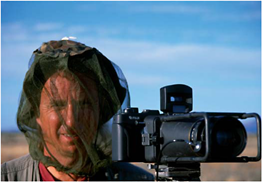
Accessories
Tripods
You can spot serious photographers by their tripods. It is the most important piece kit you’ll purchase. Perhaps news, sports and fashion photographers wouldn’t agree with me, but for the kind of images in this book, steady legs for your camera are crucial. I’m always amazed to see someone who has spent a fortune on a camera and lenses using a cheap plastic tripod that wouldn’t keep a mobile phone camera steady in a gentle breeze. A tripod is not as tantalizing a possession as a camera, but it’s a false economy to skimp on one.
As with all gear, compromises have to be made – rigidity versus portability, it’s a tough choice. All kit has to be portable to be practical, but a tripod also has to be able to support long lenses, extend up to head height and enable you to get down low. I now use a carbon-fibre tripod, which is significantly lighter than alloy legs without sacrificing rigidity. The actual weight of the tripod does contribute to its stability, but this can be aided by hanging your camera bag from the undercarriage. The head is important too; all photographers have their own tastes on these. Ball heads are popular but I can’t stand them – I prefer a geared head for precise framing adjustments.
Camera bags
When I first started in this game dinosaurs roamed the planet, leg warmers were in, and the options for carrying photo gear over the hills and far away were limited. You could use a shoulder bag guaranteed to induce numerous visits to the osteopath and that was it. I used to wrap my lenses in sweatshirts and stuff them in rucksacks. Now there is a multitude of options, with photographic rucksacks devised for every imaginable combination. I’ve got about five; in fact, I’ve lost count. One big sack the size of a coffin for when I’m carrying virtually everything, the pano and DSLR systems. One for when I’m just working with the DSLR. One for when I need to fly with a laptop. One small one for lightweight forays into crowded markets, and one for carrying camera kit and lunch, waterproofs etc. for day-long hikes. I think they’re fantastic, with one proviso, to get to your camera you have to put them down in the mud, dust and grot. But I can’t imagine life without them.

Trying to keep the flies off, the Outback, Australia
Filters
The importance of filters can’t be overstated. The need for colour filtration when shooting digitally is obviated, but I would never be without a set of Lee neutral density graduates for holding back the exposure on the sky, a polarizer for saturating the colours in vegetation and deepening the blue in skies, and a neutral density for slowing down exposures to optimize the motion in an image.

Mid-exposure in the rainforest, Costa Rica

Winter backpacking in the Cairngorms, Scotland
Miscellaneous items
In the depths of my bags all sorts of stuff lingers. The usual essentials: remote release, spare batteries, filter holder and rings, a spot meter, a hotshoe mounted spirit level, an extension ring and memory cards. And other stuff: toilet paper and matches, a Swiss Army knife, shades for peering into the sun, and sometimes a book for those endless vigils. On my wrist I have a solar-powered watch with a compass. Whenever I can take it, the mountain bike is so useful for location searches and collecting the baguettes. And on the roof of my Land Rover I have a photographic platform, big enough to get a tripod up there above the level of the hedgerows and look down on the world. Boys and their toys? Yeah, I’ll admit that one. But I can vouch for the practicality of all of them.
“All kit has to be portable to be practical”
